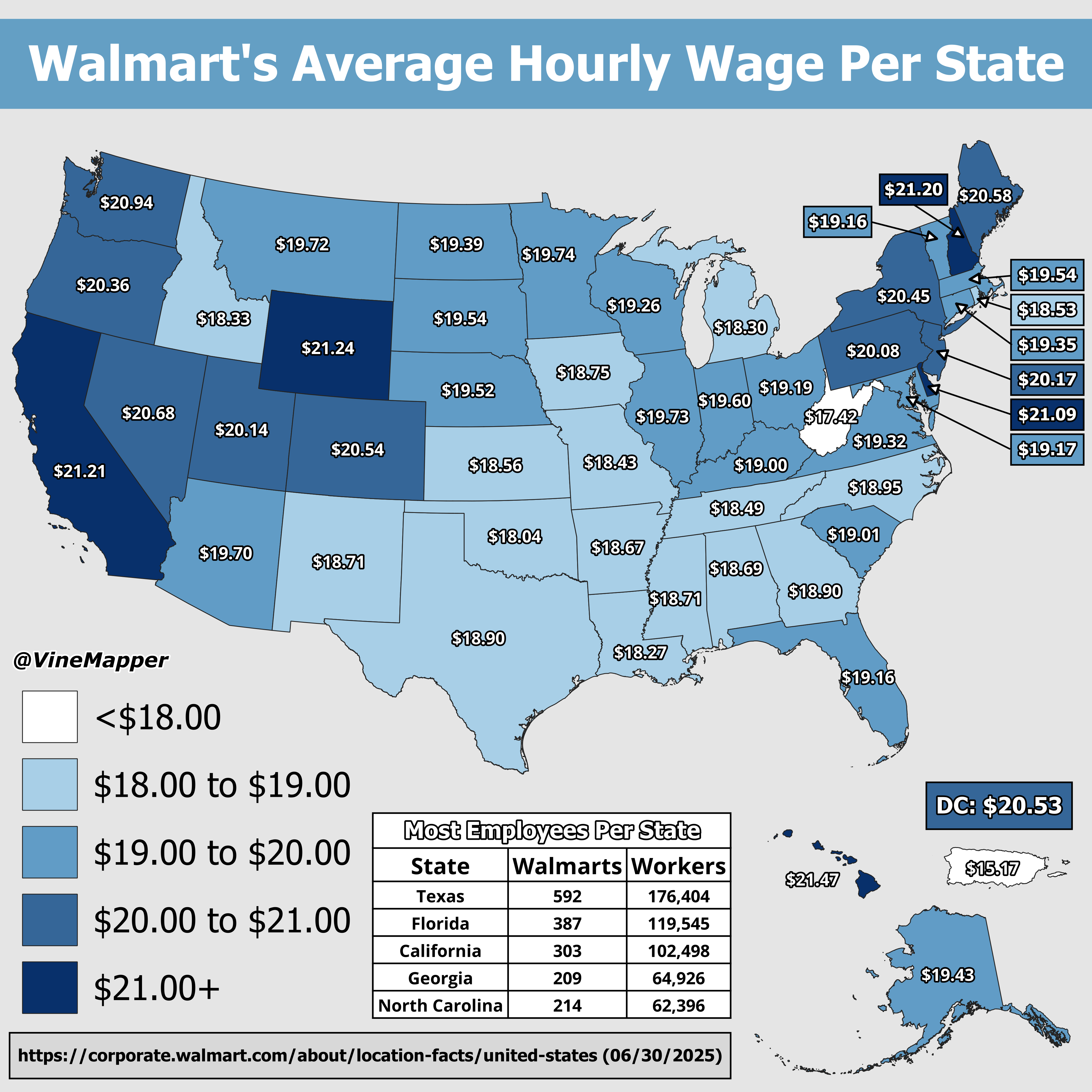Walmart's Average Hourly Wage Per State Map


Marcus Rodriguez
Historical Geography Expert
Marcus Rodriguez specializes in historical cartography and geographic data analysis. With a background in both history and geography, he brings unique...
Geographic Analysis
What This Map Shows
The visualization titled "Walmart's Average Hourly Wage Per State Map" provides a clear and informative overview of the average hourly wages paid by Walmart employees across the United States. This map highlights regional disparities in wages, showcasing how compensation varies from state to state. As one of the largest employers in the U.S., Walmart's wage structure can reflect broader economic trends and local cost-of-living factors, making this map a significant tool for understanding labor economics in the retail sector.
Deep Dive into Walmart's Wage Structure
Walmart's average hourly wage is a crucial aspect of the retail landscape and has implications for employees, local economies, and the overall job market. As of recent years, Walmart has made headlines for raising its minimum wage, aligning it closer to or even above the federal minimum wage, which currently stands at $7.25 per hour. However, the average wage varies significantly across states due to differences in labor laws, living costs, and market competition.
Interestingly, Walmart's decision to raise wages often correlates with efforts to improve employee retention and job satisfaction. In states with higher living costs, such as California or New York, the average hourly wage tends to be higher compared to states with lower costs of living, like Mississippi or Arkansas. For instance, in California, Walmart's average hourly wage can exceed $15, reflecting the higher expenses residents face in urban areas. Meanwhile, in Mississippi, it may hover around $11—still a livable wage in that region but significantly lower than in states with more expensive lifestyles.
What's fascinating is that these wage differences can also impact local economies. Higher wages in some states can lead to increased spending, which in turn stimulates local businesses and services. Conversely, in states where wages are lower, there may be less disposable income circulating within the community, affecting economic growth. This dynamic illustrates the interconnectedness of wage policies and economic health at both state and national levels.
Moreover, the wage disparities can be indicative of Walmart's market strategy. In states where competition among retailers is fierce, Walmart may increase wages to attract and retain talent. Conversely, in regions where it has a more monopolistic presence, the pressure to raise wages might be less critical. This behavior underscores the importance of market conditions in determining wage structures.
Regional Analysis
When we break down the map by regions, distinct patterns emerge. For example, in the Northeast, states like New York and Massachusetts show higher average wages, often exceeding $15 per hour. This can be attributed to both higher living costs and stronger labor unions advocating for better pay.
In the Midwest, states like Illinois and Michigan also reflect above-average wages, often driven by urban centers like Chicago and Detroit. However, neighboring states with less urbanization, such as Indiana, may see lower averages, perhaps around $12 per hour, influenced by a more rural economy and fewer labor regulations.
The South presents a mixed bag; states like Texas show a higher average hourly wage, often aligning with the cost of living in larger cities such as Houston and Dallas. Meanwhile, states like Alabama and Louisiana tend to have lower averages, which can be linked to a combination of economic factors, including lower demand for retail jobs and historical economic challenges.
Interestingly, in the West, states like Washington have some of the highest average wages in the country, often surpassing $16 per hour. This is largely due to the state's strong economy and higher living costs in cities like Seattle. Conversely, states like Idaho and Montana show lower averages, reflecting different economic conditions and labor markets.
Significance and Impact
Understanding Walmart's average hourly wage by state is not just an exercise in mapping data; it carries real-world implications. For employees, these wages affect their quality of life, purchasing power, and overall economic security. For local economies, higher wages can lead to increased consumer spending, bolstering community businesses and services.
Moreover, this topic is especially relevant in discussions about wage equality and labor rights. The ongoing debate about the minimum wage in the U.S. often hinges on the practices of large employers like Walmart, making this mapping exercise a critical component in advocating for fair wages.
Looking forward, trends indicate that as the cost of living continues to rise and workers demand better pay, Walmart and other retailers may face increased pressure to adjust their wage structures. This could lead to more equitable compensation practices across the board, significantly impacting not only Walmart employees but also the retail sector as a whole.
In conclusion, Walmart’s average hourly wage per state offers an insightful lens into the broader landscape of labor economics in the U.S. By examining these wages, we can better understand regional economic disparities, the impact of corporate policies on local economies, and the ongoing dialogue about fair labor practices in today's society.
Visualization Details
- Published
- August 8, 2025
- Views
- 146
Comments
Loading comments...